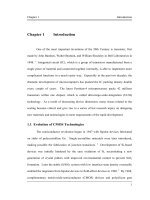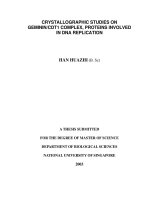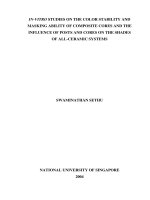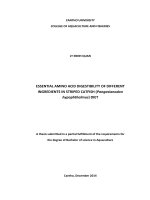studies on fungus infection in striped catfish (pangasianodon hypophthalmus) on grow out stage
Bạn đang xem bản rút gọn của tài liệu. Xem và tải ngay bản đầy đủ của tài liệu tại đây (828.33 KB, 45 trang )
CAN THO UNIVERSITY
COLLEGE OF AQUACULTURE AND FISHERIES
STUDIES ON FUNGUS INFECTION IN
STRIPED CATFISH (Pangasianodon hypophthalmus)
ON GROW - OUT STAGE
By
NGO THI MONG TRINH
A thesis submitted in partial fulfillment of the requirements for
the degree of Bachelor of science in Aquaculture
Can Tho, January 2013
CAN THO UNIVERSITY
COLLEGE OF AQUACULTURE AND FISHERIES
STUDIES ON INFECTION OF FUNGUS IN
STRIPED CATFISH (Pangasianodon hypophthalmus)
ON GROW - OUT STAGE
By
NGO THI MONG TRINH
A thesis submitted in partial fulfillment of the requirements for
the degree of Bachelor of science in Aquaculture
Supervisor
Dr. PHAM MINH DUC
Can Tho, January 2013
Acknowledgements
I wish to express my deep appreciation and sincere gratitude to my advisor Dr. Pham
Minh Duc for his constant guidance.
I also thank for Mrs. Dang Thuy Mai Thuy, Miss. Nguyen Hoang Nhat Uyen who help
devoted for me to do anything in the laboratory to finish my thesis.
I wish to express my deep appreciation and sincere gratitude to all staff of Biology and
Fisheries Diseases who give me good conditions to do my thesis.
I am very grateful to my Advanced Aquaculture class to encourage and help me more
things in that time when doing my study.
Finally, I want to thank my family that always to give me more advices and
encouraging when I feel tired.
ABSTRACT
This study was carried out the challenge test, the effects of salt and temperature on the
growth of fungus, histopathology of the fungus on striped catfish (Pangasianodon
hypophthalmus). The fungus which was used for the experiment was the isolation in the
natural. The total strains which isolating were 10 strains at An Giang province. There
were 5 strains of fungi that were used for the challenge test that has designed with two
series. The infection rate is 42.2% for 105 of concentration, and 45.6% for the 106 of
concentration. The re-isolation result showed that the fungi which were injected on fish
were mainly occurred in swimming bladder 17.2%-25.9%, kidney 10%-22.5%, and
seldom in gills 0%-6.7% of 105, and 23.3%-34.5% in swimming bladder, 13.3%-23.8%
in the kidney, and 0%-6.9% in gill of 106 for all strains. The fungus can be grown
differently when the temperature was different in the temperature test. The result
showed that the temperature was one of factor which infected to the growth of fungi
colony. The temperature which helped the fungi was good growth at 25oC-30oC, and
the best growth was 28oC, and the fungi were lower growth at 20oC, and stopped
growth at 35oC. Beside that, the sodium chlorine was also infected to the growth of
fungi. The fungi were grown well on the GYA media with 0%-8% of sodium chlorine.
The histopathology was showed that the different between of healthy fish and fish
which infected by fungi. The healthy fish was not found the fungus on the sample of
histopathology. The mycelia were appeared on the fish which affected by fungal. The
result showed that was ensured the occurring of fungi on the striped catfish which
isolated on the nature, and re-isolated on the challenge test.
CONTENTS
Acknowledgements ........................................................................................i
Abstract ..........................................................................................................ii
Contents ..........................................................................................................iii
List of tables ...................................................................................................vi
List of figures .................................................................................................vii
Chapter I: Introduction ......................................................................................... 1
1.1 Introduction.............................................................................................. 1
1.2 Objective .................................................................................................. 2
1.3 Research contents .................................................................................... 2
Chapter II: Literature review ............................................................................... 3
2.1 Status of parasites disease ........................................................................ 3
2.2 Disease caused by fungus ........................................................................ 4
2.2.1 Fungus diseases on aquatic animal ................................................ 4
2.2.2 Fungus diseases on fish.................................................................. 5
2.3 Methods using to study fungus ................................................................ 7
Chapter III: Materials and Methods .................................................................... 9
3.1 Place and time study ................................................................................ 9
3.2 Materials ................................................................................................. 9
3.2.1 Fish samples ................................................................................... 9
3.2.2 Equipments .................................................................................... 9
3.2.3 Medium and chemicals .................................................................. 9
3.3 Methods ................................................................................................... 10
3.3.1 Observation on wet-mount............................................................. 10
3.3.2 Making the wet-mount ................................................................... 10
3.3.3 Isolation and identification ............................................................ 10
3.3.3.1 Isolation method .................................................................... 10
3.3.3.2 Identification method ............................................................ 11
3.4 Examination the effect of temperature and sodium chlorine on fungus .. 11
3.4.1 The effect of sodium chlorine ........................................................ 11
3.4.2 The effect of temperature ............................................................... 11
3.5 The challenge test .................................................................................... 11
3.5.1 Collecting zoospores method ......................................................... 11
3.5.2 The challenge experiment .............................................................. 12
3.6 Examine the histopathology .................................................................... 12
Chapter IV: Results and Discussions ................................................................... 13
4.1 Clinical sign ............................................................................................ 13
4.2 Isolation and Identification ..................................................................... 14
4.2.1 Observation on the wet-mount ....................................................... 14
4.2.2 Isolation .......................................................................................... 14
4.2.3 Identification ................................................................................... 14
4.3 The effect of sodium chlorine on growth of fungus ............................... 17
4.4 The effect of temperature on growth of fungus ...................................... 18
4.5 The challenge test .................................................................................... 19
4.5.1 The clinical sign.............................................................................. 19
4.5.2 The challenge test result ................................................................. 19
4.6 Histopathology ........................................................................................ 22
Chapter V: Conclusions and Recommendations ................................................. 24
References ............................................................................................................... 25
Appendices .............................................................................................................. 28
LIST OF TABLES
Table 4.1: The average of colony diameter of fungus in sodium chlorine test .......... 18
Table 4.2: The average of colony diameter of fungus in temperature examination .. 19
Table 4.3: The infection rate of Fusarium sp. on striped catfish ............................... 20
Table 4.4: The occurring frequency of Fusarium sp. on striped catfish .................... 20
LIST OF FIGURES
Figure 4.1: The healthy fish and fungus disease fish in pond culture ........................ 13
Figure 4.2: Morphology characteristic of Fusarium sp. ............................................ 16
Figure 4.3: The characteristic of fish which using in the challenge test. ................... 21
Figure 4.4: The histopathology .................................................................................. 23
CHAPTER I
INTRODUCTION
1.1 Introduction
Striped catfish (Pangasianodon hypophthalmus) is an importance species which is
a high economy value, however, the farmers culture it with high density, and it is
easy to make their fish get diseases. There are many studies to search what kind of
diseases which can infect to catfish. General research is about pathology, the
results that are catfish can be infected by bacterial, virus, parasites, or fungi. Tu
Thanh Dung, et al. (2002) was found the bacteria disease on catfish that is very
dangerous disease because it make more risk for farmers. That bacteria is
Edwarsiella ictaluri, it infect on liver, kidney of catfish and make many death fish.
Beside that, they also do research to find the way to treat this disease. There are
many studies to search about this kind of bacteria, and show way how to know
how many Edwarsiella ictaluri are infected on catfish (Nguyen Ngoc Dung and
Dang Thi Hoang Oanh, 2010). Beside that, Nguyen Thi Thu Hang and Dang Thi
Hoanh Oanh (2011) also found that catfish can be infected by Microsporidia; it is
a group of parasite.
On the other hand, catfish can get disease from fungus, but there is no more
research to study about that. There is some research to find-out how fungi infect
on aquatic animals. In 2004, Kanit Chukanhom and Kishio Haitai were isolated
freshwater fungi from eggs of common carp (Cyprinus carpio) in Thailand. They
were isolated some kind of fungus: Saprolegnia diclina, and Allomyces arbuscula.
Fungi can be caused disease for many species of fish such as: Snakehead (Channa
striata), Climbing perch (Anabas testudineus). On study of Nguyen Thi Thuy
Hang (2011), finding about the fungi which cause disease on Channa triata in
fingerling stage with purposing is identify and put the forward to solve problem. In
2010, Tran Ngoc Tuan and Pham Minh Duc have the study on fungus which
infected on climbing perch. That study focus on biology characteristic of fungal.
Study on fungus in Vietnam is not more, that is the reason why the research
“Studies on fungus infection on striped Catfish (Pangasianodon hypophthalmus)
in grow – out stage” was done.
1.2 Objective of study
The aim is to describe isolation and identification of causative agents of fungal
infection found in the striped catfish (Pangasianodon hypophthalmus) in grow-out
stage. Beside that, the research also determines the probability to cause disease of
fungus which is the basic to prevent the fungus disease on striped catfish.
1.3 Research contents of study
o To isolate and identify fungal infection in striped catfish disease
o To examine the effects temperature and sodium chlorine on the growth of
fungus strains
o To observe histological characteristics of striped catfish with fungus infection
CHAPTER II
LITERATURE REVIEW
2.1 The status of parasites diseases
According to Bui Quang Te (2011); Tran Thi Minh Tam et al. (2003); Tran Anh
Dung (2005), they had the similar result that parasites disease can occur every
time, but the pathological can breakout when the season change about the
temperature suddenly; and the main agents are Myxobolus, Trichodina,
Ichthyophthyrius multifiliis, etc. In study of Nguyen Thi Thu Hang and Dang Thi
Hoang Oanh (2011), they found that
striped catfish (Pangasianodon
hypophthalmus) can be infected by one species of parasites with some white spots
in the body, especially focusing on belly area or lateral line when having more
opalescent or milky oval shaped cysts attacked. On first stage of this disease, it is
difficult to identify because of no symptoms. This disease is caused by
Microsporidia.
Besides that, there are many agents of parasites can cause
disease on aquatic animals. Some species of Trichodina were infected on tilapia in
pond culture of Mekong Delta. When Trichodina spp. infected on fish, there are
some symptom to recognize, such as: the mucus has opalescent fluid, the body
change to grey color, fish swimming is lazily, stay on surface. The disease can
occur and develop after the temperature is decline, especially at rainy season.
Trichodina spp. is less caused disease on adult stage, but usually infected on
juvenile stage of fish (Vemedim Company). According to Bui Quang Te (2006),
Ichthyophthyrius multifiliis is one of dangerous agent to cause disease of fish. The
clinical sign of this disease that is gill has more parasites attacked with small
opalescent spot which can call “white spot”. Skin and gill has more mucus with
pale color, fish come to lethargic. Ichthyophthyrius mutifiliis which attacked on
gill can be break-out the filament and fish cannot get oxygen; fish can be sinking
on the bottom.
2.2 Diseases caused by fungi
2.2.1 Fungi diseases on aquatic animals
Fungus is one of importance agent which is infection on aquatic animal. Following
the study of Pham Minh Duc et al. (2010) is about systematic fungus disease on
aquatic animals. This study focus on some genus of fungi: Saprolegnia, Achlya,
Leptolegnia, and Aphanomyces (Lower fungus); and study on the group of
Fusarium, Acremonium, Plectosporium, Ochroconis, Phoma, and Exophiala
(Higher fungus). That are some genus fungi which can infect on aquatic animals
(Ishikawa, 1968; Egusa and Ueda, 1972; Lightner and Fontaine, 1975; Hatai and
Egusa, 1978; Alderman and Polglase, 1985; Kitancharoen et al., 1986; Hatai et al.,
1986; Momoyama, 1987; Hatai and Kubota, 1989; Kitancharoen et al., 1995;
Kitancharoen et al., 1997; Hussein and Hatai, 1999; Diler and Bolat, 2001;
Chukanhom and Hatai, 2004; Khoa et al., 2005; Khoa and Hatai, 2005; Munchan
et al., 2009; Duc et al., 2009; Duc and Hatai, 2009; Duc, 2009). The main
characteristic of lower fungus is that the hyphae are no having septate (de Hoog et
al., 2000). Saprolegnia, Achlya, Aphanomyces are main agents to cause disease,
the hyphae of that fungi are thick and stick together; and can be reproduced with
two ways: asexual and sexual (Neish and Hughes, 1980; Yanong, 2003). Higher
fungi which can be identified by the characteristic are had the septum on hyphae
(de Hoog et al., 2000).
In the world, there are many studies on fungi that can cause diseases on aquatic
animals, especially, the fungus isolated on crustaceans and mollusks. Kitancharoen
et al. (1994) isolated and identified the fungus Atikinsiella awabi which infecting
on abalone (Haliotis sieboldii), shrimp (Pandalus Hypsinotus) in Japan which is
very sensitive with Atikinsiella awabi. The other species of that was also caused
disease on shell of abalone (Haliotis sieboldii), that species was Atikinsiella dubia
which isolated by Nakumura and Hatai (1995); and Atikinsiella panulirata
infected on crayfish (Panulirus japonicus) identified by Kitancharoen and Hatai
(1995).
Freshwater prawn (Macrobrachium rosenbergii) also got fungus disease, causing
by Fusarium sp.; Black tiger shrimp (Penaeus monodon) and crayfish (Homarus
americanus) were attacked on gill to cause black gill disease by Fusarium
incarnatum (Burns et al., 1979; Lightner and Fontain, 1975; Khoa et al., 2004).
There are some species of Fusarium genus which were agents to cause black gill
on kuruma prawn (Penaeus japonicus), that were Fusarium solani, Fusarium
mooniliforme, and Fusarium oxyporum (Egusa and Ueda, 1972; Bian and Egusa,
1981; Khoa and Hatai, 2005). Fusarium solina also infected on turtle (Carreta
carrete) (Hose et al., 1984; Cabanes et al., 1997). One agent which causing the
black gill disease on Astacus leptodactylus; and causing brown disease on
Oratosquilla oratoria, that is Acremonium spp.; in the laboratory condition, that
fungi were infected on Penaeus japonicus (Diler and Bolat, 2001; Duc et al.,
2009; Duc, 2009).
The fungus was not only infected on adult stage of crustaceans and mollusks, but
also caused diseases on egg and larvae stage. On the fungi study on larvae stage of
crab, Langenidium can cause 100% mortality if the crab larvae were infected by
that fungus. The other species was Lagenidium thermophilum which infected on
egg and larvae stage of mud crab and black tiger shrimp; Langenidium myophilum
caused disease on Pandlus hypsinotus. The Langenidium callinectes was infected
on egg and larvae stage of swimming crab (Callinectes sapidus) and other species
of swimming crab (Portunus pelagicus); and caused the disease on larvae stage of
mud crab (Scylla rerata), shrimp (Pandalus hysinotus) (Nakamura et al., 1994;
Roza and Hatai, 1999; Nakamura and Hatai, 1995; Hatai et al., 2000).
2.2.2 Fungi diseases on fish
In 2010, Tuan study on fungus in climbing perch (Anabas testudincus); and the
result showed that there were three genus which isolated Fusarium, Acremonium,
and Geotrichum. In this case, Geotrichum has highest occurring frequency (60%),
30% is occurring frequency of Fusarium, and less occurring frequency was
Acremonium (10%). The symptom of this disease that was more mucus on the fish
body, and scale was lumpy. The result of Saylor et al. (2010) found that
Aphanomyces invadans was the agent to cause Ulcerative on snakehead (Channa
striata). Epizootic Ulcerative Syndrome (EUS) was the dangerous disease; it can
be transmissions very rapidly and make more risk for farmers in the world. That
disease caused by more agents: bacteria, parasites, and some lower fungi group
such as: Aphanomyces spp., Saprolegnia spp., and Achlya sp. However, the main
agent that causes ulcerative was Aphanomyces invadans. If having suitability
condition, Aphanomyces invadans will attack to the tissues on fish body, and
releasing the enzyme to breakup the protein to make the ulcerative on body of fish
(Hoa et al., 2004). In 1984, Hatai isolated this fungus on fish which having
ulcerative on body. Saylor et al. (2010) also found that Aphanomyces invadans
was fungi which cause disease on snakehead (Channa triata) in United States.
Channa triata was very sensitive with Aphanomyces invadans. When isolated the
fungus on snakehead (Channa triata), Lilley et al. (1997) also saw that fungi
cause EUS disease. Hoa et al. (2004) found that some symptoms to recognize EUS
disease: less or no feeding, less active, when swimming the injury of fish stay in
water surface. The skin of fish change to dark color, the injury was grey and
widely to make large ulcerative, missing scales, and haemorrhage (Saylor et al.,
2010). When fish got seriously disease, the ulcerative was very large which can
see the bone and the internal organs. However, internal organs do not have any
disease symptoms, when surgery of fish (Hoa et al., 2004). EUS disease can be
transmitting by water quality, fish transmission. Actually,
Aphanomyces
invadans was only infected on fish when they have the primary disease which
cause some necrosis on fish body because Aphanomyces invadans was secondary
agent to cause disease. Therefore, protecting fish in good condition plays the
importance role when culturing fish. In 2007, Panchai et al. isolated the Achlya
bisexualis which infected on tilapia in Thailand. Achlya bisexualis was white
colonies, it has two parts: one part was attached on body of fish; the other part was
freed on environmental. It can grow GY liquid medium, the result showed that the
hyphae were touch, no septate; the suitability temperature was about 25-30oC, and
cannot grow at 40oC, salinity was 15ppt, and grown at 20-40ppt. There were some
studies in Singapore, Sinmuk et al. (1996) was showed that Aphanomyces sp.
infected on Pelodiscus sinensis; and Hanjavanit et al. (1997) also isolated
Aphanomyces sp. on ornamental fish.
There were many species of fungi can cause diseases on egg and larvae stage of
aquatic animals. Following the result of the survey, there are four genuses of fungi
that can infect on snakehead (Channa triata): Acremonium, Geotrichum,
Aphnomyces, and Fusarium. They also known that the species was Aphanomyces
frisgidofilus which made the egg of aquatic animal could not hatch. In the other
study, Czeczuga et al. (1996) believed that salmon fish in egg stage were very
sensitive with more genus of fungi Leptolegnia, Saprolegnia, and Achlya. In
Thailand, the egg stage of tilapia also got diseases by some common species of
fungi that are Saprolegnia diclina, Achlya klebsiana, and Allomyces arbuscula.
40oC and pH is 6-8 that are good condition for Allomyces arbuscula growth.
2.3 Method using to study fungi
Fungus which was one of agent to cause disease on aquatic animals has more
studies in the world. The fungus diseases can study base on symptoms,
morphology, and biochemical characteristic of isolated fungal. Isolation,
identification, and culturing on agar medium are the common using method (Hatai
and Egusa (1979); Neish and Hughes (1980); Khoa et al., 2004; Duc et al., 2009).
There are some medium usually use such as: Cherry-decoction agar, Cornmeal
agar, Oatmeal agar, Potato-dextrose agar, Glucose-glutamate, Gys-tellurite, or
YpSs-tellurite (Gams et al., 1980). Beside that, GYA, and PGYSA media which
using with fungus caused disease on freshwater and brackish water (Hatai and
Egusa, 1979); Khoa et al., 2004; Duc et al., 2009). Some antibiotic which were
streptomycin and ampiciline were usually used to add in medium for isolating the
fungi (500µg/ml) (Khoa et al., 2004; Duc et al., 2009). The way to make pure
culture was that cutting the small part of agar which contents fungus and move to
other Petri dish, replacing on 2-3times (Gams et al., 1980; Ho and Ko, 1997).
The tradition method for studying the fungus was using popularly, nowadays, the
biological molecular which development rapidly was also using to check the
occurring of fungus on the sampling (Atkins and Clark, 2004). This method was
popular for diagnostic on aquatic animals; some technical was used: PCR,
restriction enzyme digestion, probe hybridization, and microarray (Altinok and
Kurt, 2003; Atkins and Clark, 2004).
Histopathology is applying to evaluate the occurring of fungus in sampling. There
are some stain methods such as: Hematoxyline and Eosin (H&E), Grocott’s stain,
PAS stain. Grocott’s stain is used methenamine-silver to find fungus which their
hyphae can take brown and black color. Periodic – Schiff acid is only used for
PAS stain to identify the fungus that hyphae can take pink and red color (Johnson
et al., 2004; Hanjavanit et al., 2008; Duc and Hatai, 2009).
CHAPTER III
MATERIALS AND METHODS
3.1 Place and study time
The study was carried out in An Giang province from June to December in 2012.
The experiments were done at the Department of Aquatic Biology and Pathology
of Can Tho University.
3.2 Materials
3.2.1 Fish samples
The fish sample will be collected in one month with 2weeks/time. The fish which
has some characteristics: necrosis, spots, or injury on the body was collected. The
healthy fish was also collected because of making the comparative. There were 65
fish which collected, in side; there were 55 diseases fish, and 10 healthy fish.
3.2.2 Equipments
There are many types of equipment which used in this study such as: Petri dish,
test tube, surgical, alcohol lamp, micropipette, trays, cork borer No.2, fridge,
microscope, and incubator. These equipments which using to isolate the fungus on
fish, culture the fungus to get pure culture, observe the characteristics of fungus,
and keep the fungus in the long time.
3.2.3 Medium and chemicals
The medium that used in this study was GYA media with the ingredients: Glucose
(1%), Yeast extract (0.25%), and Agar (1.5%). That medium used to isolate the
fungus on fish, and culture the fungus.
This study was also used some the chemicals which was saline solution using to
treat the specimen before isolation; cotton blue using to stain the sample to find
out the mycelium on the fish or observing the characteristic of mycelium. Some
drugs were also using to inhibit the other agents to grow on the culture of fungus:
ampicillin, streptomycin.
3.3 Methods
3.3.1 Observation on wet-mount
Following the method of Gams et al., (1980); Hatai et al., (2000), using the naked
eyes to observe the samples. They have ulcerative, or some white bunch on fish
body; we will start to observe with wet-mount on microscope.
3.3.2 Making the wet-mount
To take a part of sampling; drop one drop of saline solution; Cover the sample
with cover-slip; Observing on microscope in 20X or 40X to find the occurring of
mycelia or spore, and determination that the mycelia have or do not have septum
(Gams et al., 1980; Hatai et al., 2000)
3.3.3 Isolation and identification
3.3.3.1 Isolation method
Following Hatai et al., (2000), fresh specimen is observed on microscope. If the
hyphae are occurred, isolation will start. Washing that sampling 3 times with
saline solution (0.85% NaCl), after that, inoculating into the GYA medium which
added streptomycin (500µg/L) to inhibit other transmission; starting to incubate at
28oC, in 4 days in the incubator.
After 4 days, the fungus grew on GYA medium, in this time, culturing the fungus
which was 2-3 times to get pure culture. Cutting a small part of colony with 35mm diameter of agar, bring it to the new GYA medium to take pure culture.
(Hatai et al., 2000)
3.3.3.2 Identification method
The fungus culture was on the lame which followed to the Riddells’s that was
done in the sterilization condition (Gams et al. 1980). The details showed on the
appendix 2
3.4 Examine the effects of temperature and sodium chlorine on fungus growth
3.4.1 The effect of sodium chlorine
Cutting a small piece of colony of fungal in pure culture by cork borer No.2 was
about 5.5mm to culture on GYA medium with differ concentration of sodium
chlorine: 0%, 2%, 4%, 6%, and 8% at 28oC. The experiment is replaced 3 times.
Following and taking note about the diameter of colony in 5 days.
3.4.2 The effect of temperature
The temperature is a factor to affect about the growth of fungus. This study was
done the experiment to test the growth ability of fungus at differ temperature
(Khoa and Hatai, 2003).
The pure culture of higher fungi were cultured on GYA medium at 280C in 5 days.
Next, cutting a small part of agar which content the fungal to the other GYA
medium and incubating in five differ temperature: 20, 25, 28, 30, and 35oC. This
experiment is replaced 3 times. Following and taking note about the diameter of
colony in 5 days.
3.5 The challenge test
3.5.1 Collecting zoospores method
The method to collect zoospores for challenge test was accorded to Pham Minh
Duc, Shinpei Wada, Osamu Kutara, and Kishio Hatai; 2010. The details were
showed on the appendix 3.
The way to determine the number of zoospore (Duc, 2009)
M= B x 104
Where:
M is density of zoospore (spore/ml)
B is total spore in 25 plots
3.5.2 Challenge experiment
The challenge test is a way to test the transmission of disease. The experiment was
done with two treatments, two replications and one control. The test took care in 4
weeks.
The fish which was choice for challenge test must be good healthy with the body
weight is about 25g and length is about 16-18cm. Experiment was designed with
10 fish in one tank (60 litters/tank) with two replications. The fish was cultured in
the tank (0.5 m3) 15 days, and check the parasite and bacteria before was done in
the experiment. The fish was injected with 0.2ml of conidia per one fish in the
treatment tank, and 0.2ml per one fish of sterile saline solution (0.85% NaCl) in
the control tank.
3.6
Examine histopathology
Fish samples were collected and fixed in neutral formalin solution 10%,
expediting processing, casting blocks, cutting samples and staining samples follow
H&E. The details were showed on appendix 13, 14, and 15. There were 20
samples which used in this experiment; in case, 15 samples that infected by fungus
and 5 samples did not cause disease by fungus.
3.7 Data analysis
Excel was used to analyze the data in this study
CHAPTER IV
RESULTS AND DISCUSSIONS
4.1 Clinical sign
Striped catfish (Pangasianodon hypophthalmus) was infected by fungus which
was not having clearly clinical sign, it was difficult to recognize. This disease was
occurring in the pond which cultured fish on 3-5 months, fish was no feeding,
sluggish, and swimming on the surface. When the fish was surgical, the main
clinical sign was the swimming bladder that was swollen with white fluid and
bubble (Fig 4.1).
A
B
C
D
Figure 4.1: The healthy fish and fungus disease fish in pond culture. (A): The fish
which non-fungus infection; (B): The fluid and bubble in the swimming bladder of
stripped catfish; (C): The fungus colony in the GYA medium; (D): The
macroconidia of fungus with cotton blue staining (arrows showing)
4.2 Isolation and identification
4.2.1 Observation on the wet-mount
The sampling was checked the parasite, the occurring of the fungus that was
infected on the fish before isolating the fungus. Parasite has infected on the fish,
but it was only 2-3 individuals per lame. That parasite which attacked on striped
catfish was Trichodina spp. That is not the main agent to cause disease on fish.
4.2.2 Isolation
The sample was cut a small part to wash with sterile saline solution (0.85% NaCl)
three times, put it on the GYA medium, and add the ampicilin and streptomycin
(500µg/l) to inhibit the other transmissions, incubating it on the incubator at 28oC
in 4 days (Hatai et al., 2000). After 4 days, the fungus grew on GYA medium, in
this time, culturing the fungus was 2-3 times on the GYA medium to get pure
culture.
The results showed that there were 10 strains of higher fungi were isolated from
twenty ponds with fifty-five fish which cultured striped catfish in An Giang
province, among that there were fifty fish was not health, and five healthy fish.
Following the morphology characteristic, the growth of the colony on the GYA
medium was grouped them on one group (AG1201, AG1202, AG1203, AG1204,
AG1205, AG1206, AG1207, AG1208, AG1209, and AG1210), that was showed
on the appendix 1. In contract, the fish was without the clinical sign which cannot
have the fungus.
4.2.3 Identification
The fungus was identified by the Hoog et al., (2000), the pure culture of fungus
was used to identify by the way that was putting the paper with some water in the
Petri dish, placing the lame on the V shape of glass rod, after that, the small part of
agar (5mm2) put on the lame, the fungus was cultured on the 4 places of agar, and
cover it by the lamella, that Petri dish was incubated on the incubator at 28oC in 4
days. When the fungi grew nearly full the lamella, it was moved to the other sterile
lame with one drop of cotton blue. To place it that should be slowly with 45o of
angle to avoid the bubble.
The results showed that all ten strains of fungus was group on the Fusarium sp.
basing on their morphology characteristic and the growth of the colony on GYA
medium (showing on the Figure 4.2). The colony was round (Fig 4.2A), the edge
can be steady or not, orange, cream or pink color, the mycelia were emerged
growing with the agar (Fig 4.2B), the hyphae had the septum and branching,
especially, the conidia had the falcate shape and 10µm in length with observation
on 40X of microscope, they grew well in 28oC, and their diameter was 4.5cm after
7 days. Following the Hoog et al., 2000, that was Fusarium sp.
A
B
C
D
E
F
Figure 4.2: Morphology characteristic of Fusarium sp. (A): The colony of fungus
AG1205 on the GYA medium at 28oC; (B): The mycelium was emerged growing
on the GYA medium; (C): The mycelia had septum with cotton blue staining
(40X; showing of arrow); (D): The conidia had falcate shape, staining with cotton
blue (100X; showing of arrow); (E): The stalk of fungus with cotton blue staining
(40X; showing of arrow); (F): The stalk of fungus with cotton blue staining (100X,
showing of arrow)
Following that morphology characteristic and the type of colony of the fungus,
and combine with the identification system of de Hoog et al. (2000), the genus of
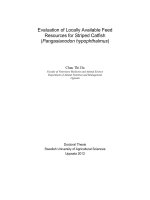

![pike - 2003 - studies on audit quality [aq]](https://media.store123doc.com/images/document/2015_01/06/medium_skm1420548229.jpg)
